A story built on love, self-doubt, and emotional growth, Relationship Goals presents a complicated journey of two individuals trying to make sense of what it means to commit. The film begins with bold promises and passionate energy but slowly steers toward the uncomfortable truths that often lie beneath modern relationships.
As the plot stretches deeper into the personal conflicts of the lead couple, it becomes clear that love alone may not be enough to keep them together. With every argument and misunderstanding, their bond gets tested, revealing parts of themselves they had previously ignored or suppressed.
While the film initially appears to promote social media romance ideals, it takes a turn by showing what happens when couples try to live up to those appearances. Tunde and Kemi, the central characters, are both drawn to each other’s potential but carry baggage that neither wants to confront fully.

Their attempt to build a perfect love story on fragile ground only magnifies their hidden insecurities. The ending does not simply focus on whether they stay together but instead on what they learn through their time apart and how they grow from that space.
Viewers are shown how emotional honesty and deep self-awareness can influence romantic decisions. The strength of Relationship Goals lies in its ability to change the focus from romance to individual reflection without losing its emotional pulse. It does not paint love as flawless but as something that must be built with truth and personal accountability.
The Illusion of Perfect Love
Kemi enters the relationship with a dream many can relate to. She wants lasting affection, support, and security. Her ideas about love are drawn from online images and surface-level advice.
She tries to mold the relationship into something worthy of attention, something people can admire from the outside. Tunde, on the other hand, enjoys her warmth and passion but feels smothered by the pressure to keep up appearances.
Their chemistry is evident, yet the two constantly misunderstand each other’s expectations. Kemi wants vulnerability but doesn’t create space for it. Tunde craves understanding but refuses to express himself fully. These patterns become more visible as they move in together and their daily realities set in.
The film uses these moments to question the idea that every couple must follow a polished path. Their problems stem from communication breakdowns, silent disappointments, and personal fears. When these feelings remain unspoken, tension builds and erupts in the form of mistrust and frequent arguments.
Tunde’s Emotional Wall and Kemi’s Need for Validation
Tunde carries the weight of past relationships that didn’t end well. He uses silence and avoidance as tools to protect himself. He fears giving too much and ending up broken again. Kemi sees his distance as rejection and responds by demanding more attention. She begins comparing their relationship to others, often pressuring him without realising it.
The beauty of the writing lies in how it treats both characters with balance. Tunde is not made into a villain for his hesitation, and Kemi is not blamed for her emotional needs. Their flaws are presented with honesty, allowing the audience to see how their struggles mirror many real-life situations.
As Tunde continues to hide behind jokes and Kemi keeps pushing for more signs of affection, both feel increasingly alone. Eventually, their relationship begins to shake under the weight of unspoken pain. The final argument before their break is not explosive but quietly heartbreaking. They each admit they no longer recognise the person they fell in love with.
The Break That Brings Clarity
After the breakup, both characters go through separate journeys that are not about finding new partners but about understanding themselves better. Tunde begins therapy and starts unpacking his emotional habits. He starts to realise how much fear has guided his past choices and relationships. Kemi, on the other hand, takes time off social media and returns to her journal, where she documents her emotions and reflects on her patterns.
The film avoids rushing the process of healing. Tunde’s sessions reveal how being emotionally shut down protected him from rejection but also isolated him from real intimacy.
Kemi learns that seeking constant validation from others left her blind to her own self-worth. These moments are quietly powerful and remind the audience that real change takes time, effort, and a willingness to confront hard truths.
Rather than meeting new love interests, the story focuses on the characters confronting the parts of themselves they once avoided. It is through this internal work that they begin to soften and understand the damage they did to each other and to themselves.
Reconnecting Without Pressure
Months pass before they reconnect. Tunde reaches out with a letter, not to ask for a second chance, but to express his growth and remorse. Kemi reads it, reflects deeply, and agrees to meet, not with romantic expectations, but to close that chapter with clarity.

Their meeting is quiet and respectful. They speak as two people who once loved each other but now see the situation with clearer eyes. Kemi admits she had unrealistic expectations while Tunde acknowledges that emotional distance was his way of hiding. There’s no dramatic reconciliation, no last-minute kiss, only two people choosing peace over pain.
This meeting does not suggest that they are back together but leaves space for the idea that something new might grow—if not romance, then mutual respect or friendship.
The film carefully avoids suggesting that every relationship must end in reunion. Instead, it highlights how healing and personal growth can be outcomes just as meaningful.
Messages Behind the Ending
What Relationship Goals does effectively is move the focus from traditional romance to the importance of emotional responsibility. It asks viewers to think beyond fairy tale endings and consider the effort required to sustain love in reality. By doing so, it brings to light how societal pressures and unspoken trauma can tear people apart if not addressed properly.
The closing scene leaves a gentle impression. Kemi walks through a bookstore, now working part-time as a writer. Tunde watches from across the street with a smile before walking away.
There are no words, no dramatic music, only calm acceptance. This final moment allows viewers to imagine different possibilities based on their own experiences and beliefs.
The film reminds its audience that relationships cannot survive on love alone. They demand clarity, personal honesty, and courage to accept the things we fear most. By the end, it becomes clear that Relationship Goals is not a guidebook on romance but a reflection on what it means to really know yourself and how that affects the way you relate with others.
Relationship Goals is available to stream online. Viewers can watch it on Netflix and Amazon Prime Video. Whether you are watching it for the first time or returning for a second look, both platforms offer the complete film in high quality with the option to include subtitles.
(Updated: Jun 17, 2025)



